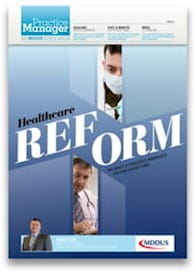Day one
1: A 78-year-old woman – Mrs B – attends her local surgery for a routine blood test. She is on long-term warfarin therapy after having suffered a pulmonary embolism. Staff at the practice monitor her INR (International Normalised Ratio) and adjust the warfarin dosage on the basis of a detailed programme implemented after consultation with the local haematology department.
Frequent dose adjustments are required to maintain the therapeutic action of the drug and minimise side-effects. Under-anticoagulation can lead to thrombosis and over-anticoagulation to bleeding. The practice keeps a warfarin register with a page for each patient being treated with the drug. Each time a blood sample is taken one of the doctors enters the latest INR level along with the current warfarin dose and any necessary change that might be indicated. The patient is contacted with this information along with the date of the next test.
Day two
2: An INR result is received for Mrs B from the lab and the practice sends out a letter informing her that although her INR is near the upper end of the acceptable range there is no need to change her warfarin dose. Her next test is scheduled for two week’s time
Day nine
3: An INR result is received in the practice for another patient with a similar name to Mrs B. One of the doctors mistakenly adds the result – which is just below the acceptable range – to Mrs B’s page in the warfarin register.
Day ten
4: A practice nurse who monitors the register notices the low result for Mrs B and as per a set protocol phones Mrs B and tells her to increase her warfarin dose.
Day sixteen
5: Mrs B has missed her scheduled blood test due to a very painful leg. Later that day she asks for a home visit and the attending doctor diagnoses a large haematoma in her thigh. Back at the practice the doctor checks the original computerised lab results and finds the erroneous result added to Mrs B’s page in the register. She is hospitalised and tests reveal a dangerously high INR and she is also found to be very anaemic. She responds well to treatment and fortunately makes a full recovery although with pain and inconvenience.
ONE month later a letter of complaint is received by the practice from Mrs B’s son over his mother’s treatment. The practice manager investigates the matter and with the advice of MDDUS frames a response letter in which she first apologises for the errors that led to Mrs B’s condition and hospitalisation. She writes that the practice had been confident that the system used to monitor warfarin treatment in patients was foolproof but Mrs B’s treatment had clearly demonstrated this was not the case.
A SEA (significant event analysis) is to be conducted and the protocol re-examined – with particular regard to the potential for human error – in order to ensure that such a mistake will not happen again to any patient at the practice. She offers to report on the outcome of the SEA and meet with the family along with the doctors to discuss the matter if desired. It is also pointed out that if Mrs B and the family are dissatisfied with the explanation provided they are “free to seek an independent review”.
Mrs B’s son replies to the practice manager thanking her for the full and frank response and states the family is satisfied now that it was simple human error and not a lack of care that led to the treatment failure. No further action is taken in the case.
KEY POINTS
• Ensure you have an effective results handling process.
• Make sure systems are as ‘fail safe’ as possible.
• Anticoagulants are among the drugs most associated with fatal medication errors so take particular care with patients being treated with warfarin to ensure any changes in dose are based on sound protocols and are accurately and clearly communicated.
• Ensure careful sharing of responsibility for tests and results handling.
Alan Frame is risk adviser with MDDUS Training and Consultancy
This page was correct at the time of publication. Any guidance is intended as general guidance for members only. If you are a member and need specific advice relating to your own circumstances, please contact one of our advisers.
Read more from this issue of Practice Manager

Save this article
Save this article to a list of favourite articles which members can access in their account.
Save to library

